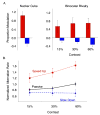Can attention selectively bias bistable perception? Differences between binocular rivalry and ambiguous figures
- PMID: 15330700
- PMCID: PMC1403736
- DOI: 10.1167/4.7.2
Can attention selectively bias bistable perception? Differences between binocular rivalry and ambiguous figures
Abstract
It is debated whether different forms of bistable perception result from common or separate neural mechanisms. Binocular rivalry involves perceptual alternations between competing monocular images, whereas ambiguous figures such as the Necker cube lead to alternations between two possible pictorial interpretations. Previous studies have shown that observers can voluntarily control the alternation rate of both rivalry and Necker cube reversal, perhaps suggesting that bistable perception results from a common mechanism of top-down selection. However, according to the biased competition model of selective attention, attention should be able to enhance the attended percept and suppress the unattended percept. Here, we investigated selective attentional modulation of dominance durations in bistable perception. Observers consistently showed much weaker selective attentional control for rivalry than for Necker cube reversal, even for rivalry displays that maximized the opportunities for feature-, object-, or space-based attentional selection. In contrast, nonselective control of alternation rate was comparably strong for both forms of bistable perception and corresponded poorly with estimates of selective attentional control. Our results support the notion that binocular rivalry involves a more automatic, stimulus-driven form of visual competition than Necker cube reversal, and as a consequence, is less easily biased by selective attention.
Figures









Similar articles
-
Attending to auditory signals slows visual alternations in binocular rivalry.Vision Res. 2010 May 12;50(10):929-35. doi: 10.1016/j.visres.2010.03.010. Epub 2010 Mar 23. Vision Res. 2010. PMID: 20338191
-
Brain networks underlying bistable perception.Neuroimage. 2015 Oct 1;119:229-34. doi: 10.1016/j.neuroimage.2015.06.053. Epub 2015 Jun 26. Neuroimage. 2015. PMID: 26123379
-
Distributions of alternation rates in various forms of bistable perception.J Vis. 2005 Apr 4;5(4):287-98. doi: 10.1167/5.4.1. J Vis. 2005. PMID: 15929652
-
Interacting competitive selection in attention and binocular rivalry.Prog Brain Res. 2005;149:227-34. doi: 10.1016/S0079-6123(05)49016-0. Prog Brain Res. 2005. PMID: 16226587 Review.
-
How does binocular rivalry emerge from cortical mechanisms of 3-D vision?Vision Res. 2008 Sep;48(21):2232-50. doi: 10.1016/j.visres.2008.06.024. Epub 2008 Aug 13. Vision Res. 2008. PMID: 18640145 Review.
Cited by
-
Perceptual, cognitive, and personality rigidity in Parkinson's disease.Neuropsychologia. 2015 Mar;69:183-93. doi: 10.1016/j.neuropsychologia.2015.01.044. Epub 2015 Jan 30. Neuropsychologia. 2015. PMID: 25640973 Free PMC article.
-
Pre-exposure to Ambiguous Faces Modulates Top-Down Control of Attentional Orienting to Counterpredictive Gaze Cues.Front Psychol. 2020 Sep 9;11:2234. doi: 10.3389/fpsyg.2020.02234. eCollection 2020. Front Psychol. 2020. PMID: 33013584 Free PMC article.
-
Changes in low-level neural properties underlie age-dependent visual decision making.Sci Rep. 2018 Jul 17;8(1):10789. doi: 10.1038/s41598-018-27398-x. Sci Rep. 2018. PMID: 30018453 Free PMC article.
-
Multisensory constraints on awareness.Philos Trans R Soc Lond B Biol Sci. 2014 Mar 17;369(1641):20130207. doi: 10.1098/rstb.2013.0207. Print 2014 May 5. Philos Trans R Soc Lond B Biol Sci. 2014. PMID: 24639579 Free PMC article. Review.
-
Increased readiness for adaptation and faster alternation rates under binocular rivalry in children.Front Hum Neurosci. 2011 Nov 4;5:128. doi: 10.3389/fnhum.2011.00128. eCollection 2011. Front Hum Neurosci. 2011. PMID: 22069386 Free PMC article.
References
-
- Blake R. A neural theory of binocular rivalry. Psychological Review. 1989;96:145–167. [PubMed] - PubMed
-
- Blake R. A primer on binocular rivalry, including current controversies. Brain & Mind. 2001;2:5–38.
-
- Blake R, Logothetis NK. Visual competition. Nature Reviews Neuroscience. 2002;3:13–21. [PubMed] - PubMed
-
- Blake R, Westendorf DH, Overton R. What is suppressed during binocular rivalry? Perception. 1980;9:223–231. [PubMed] - PubMed
-
- Bossink CJ, Stalmeier PF, De Weert CM. A test of Levelt’s second proposition for binocular rivalry. Vision Research. 1993;33:1413–1419. [PubMed] - PubMed
Publication types
MeSH terms
Grants and funding
LinkOut - more resources
Full Text Sources

